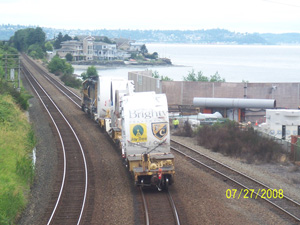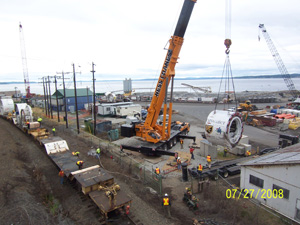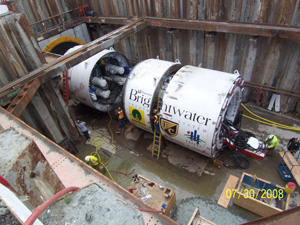Shani Wallis, Editor
- Breakthrough of this LOVAT EPBM after its 14,050ft (4.2km) long drive for the Brightwater conveyance tunnel facility in King County, north of Seattle, Washington, takes the East Tunnel contract off the project's critical path and brings on to it the Central Tunnel contract. The two Herrenknecht Mixshields on the Central Tunnel drives are battling abrasive glacial deposits and high groundwater pressures. At the downstream end, the project's second LOVAT EPBM is away to a positive start on the longest single heading on the project, the 21,100ft (6.4km) drive for the West Tunnel contract.
-

Luminata’ breakthrough
- The LOVAT EPBM ‘Luminata’ on the East Tunnel contract broke through for the Kenny/Shea/Traylor JV in November 2008 after taking about 14 months to complete its 14,050ft (4.2km) drive. On its journey through varying amounts of gravel, silt and clay, the 19ft 3in (5.8m) o.d. machine worked under a maximum 4 bar EPB pressure and its crews recorded a best weekly rate of 540ft (165m) (working two 10h shifts/day, six days/week) and set averages of 350ft/week. Installation of the four wastewater-carrier pipelines into the 16ft (4.8m) i.d. tunnel is now underway towards the contract’s completion date in November 2009. Meanwhile, ‘Luminata’ is on its way to Milwaukee to work on a new sewer tunnel contract for Kenny Construction.
-

Brightwater conveyance tunnel plan
-
Central Tunnel
It is the combination of abrasive glacial deposits, a deep tunnel alignment, and a high ground water table that has the two Herrenknecht Mixshields on the Central Tunnel contract for the Vinci/Parsons RCI/Frontier-Kemper JV running well behind schedule. - Both 17.4ft (5.3m) diameter slurry Mixshields are working in opposite directions from the 55ft i.d. x 90ft deep (16.8m x 27.5m) North Kenmore access shaft, the first machine started in September 2007 and the second launched in February 2008. By mid-January, the first machine was about 6,500ft (2,000 m) or 50% into its 11,600ft (3.5km) BT-2 east drive and the second was some 30% or 6,000ft (1,800 m) into its 20,100ft (6.2km) BT-3 journey westward (Fig 1).
- “Our problem is that cutter wear is higher than expected and there are no favorable reaches of clay in which we can stop to make cutter changes under reasonable air pressures,” said Lionel Suquet, Project Manager for the JV. “Cutter changes are being undertaken under air pressure of up to 4.4 bar.” This allows only 45 minutes of work by the compressed air maintenance crews with three hours in decompression. “We have up to six compressed air maintenance crews of three men in each in a 24-hour period, but it is taking up to three times 45-minutes to change just one cutter.”
- Add to this the higher than expected need for cutter changes. “On the 12,000ft (3.6km) of tunneling advanced to date, we have had more than 250 hyperbaric interventions,” said Suquet. “We are several months behind where we should be in our program and there is little to improve advance rates in this wide rage of different ground conditions. At between 200-400m deep, it is impossible to establish zones of treated ground from the surface in which cutter changes can be undertaken in lower compressed air pressures, and creating zone of grouted ground from the tunnel heading is not a viable option. Groundwater pressures of 7.5 bar are predicted in the contract’s GBR and we have encountered pressures up to 5.2 bar to date as well as high artesian water pressure.” When TunnelTalk contacted the site in early January, the BT2 TBM was on a one-month maintenance downtime and the BT3 TBM was on a two-week cutter change downtime.
-

Geological section
-

Central Tunnel Mixshield TBM
- Over the course of the drives however, there have been periods of good advance. Progress rates of 15-20 rings/day, through reaches of sand and gravels have been recorded, working three 8h shifts/day, and the best to date is 24 rings or 120ft (40m) in a single day. Through ground with a higher clay content, progress drops to about six rings/day or less with slurry taking longer to process through the treatment plant. This is the contradiction for the contract. Clay is needed to provide man-entry cutter changes at lower compressed air pressures, but it does slow up advance rates for the slurry system TBMs.
- At another point, the east tunnel BT2 machine passed under shallow cover of about 30m and experienced slow progress during August and September 2008. It is believed that high volumes of ground water flowing into the TBM excavation chamber was in a direct link with the creek above.
- Elsewhere on the contract, the JV is completing construction of the Ballinger shaft into which its east heading BT3 machine will breakthrough and be retrieved. The 205ft deep x 21ft i.d. (62.5m x 6.5m) shaft was excavated as a ground freezing operation installed by subcontractor Moretrench and slip-lining of the final concrete lining by subcontractor Headlands, recently finished. “This was a successful technical operation,” said Suquet. The JV’s BT2 machine is mining west towards breakthrough into the influent structure shaft on the Kenny/Shea/Traylor JV East Tunnel contract at the North Creek construction site. The BT4 LOVAT TBM excavating the West Tunnel will breakthrough also into the Ballinger shaft.
-

West Tunnel LOVAT EPBM
-
West Tunnel
Arrival of the new LOVAT EPBM for the Jay Dee/Coluccio/Taisei JV on the West Tunnel contract in late July 2008 was delayed by about five months but after a tidy assembly, the 15ft 5in (4.7m) diameter machine launched on 10th September 2008. By mid January, the machine was about 3,000ft (920m) into its 21,100ft (6.4km) drive and turning in positive advance rates. - “The machine is doing good,” said Mina Shinouda, Assistant Project Engineer for the JV. “We are getting between 400ft and 500ft (121-152m) per week, working two 10h shifts/day, 5 days/week. Our best daily production to date is the 22 rings or 110ft progressed on 10 December 2008, and the best week so far was the 88 rings or 440ft recorded in November. This is a bit faster than our contract program. We won’t be able to make up all the delay but we are trying to catch up on some of it.” Breakthrough into the Ballinger Way Shaft is revised from the original schedule of November 2009 to March 2010.
- The Central Tunnel contract has a longer combined length of tunnel to excavate but the West Tunnel drive is the longest on the project with no intermediate shafts. “This makes it more challenging from the survey aspect and for TBM face maintenance,” said Shinouda. “So far we have no major discrepancies from the contract’s GBR and its boulder counts, and over the first 3,000ft of tunneling there has been no need for an intervention. We sent through a camera in free air to check man-entry inspection conditions in the plenum but seeing water coming in we postponed the intervention. We will undertake a compressed air intervention when tool changes become necessary.”
- As the TBM advances away from the working shaft at the shore of Puget Sound, the increasing cover sees an increase of the groundwater table and of the working pressures. Into the second half of the drive, working pressures will be up to 5 bar. Cutter changes and maintenance may have to be undertaken in compressed air and to support this the TBM is fitted with air locks and the site has the necessary compressors and medical lock decompression chambers on the surface.
- The machine is also fitted with the EPB soil conditioning and a through-the-tailseal annular grouting system as specified by the tunnel designers to cope with the complex geological conditions and to limit surface settlement as the tunnels pass under urban areas. The conventional design-bid-build contracts are designed by Montgomery Watson Harza/Jacobs Associates (MWH/JA) JV, with geotechnical engineer Camp Dresser McKee (CDM) for the King County Wastewater Treatment Division of the Department of Natural Resources and Parks.
- The segmental linings for all three tunnel contracts are designed by Hatch Mott MacDonald and are being produced by CSI-Hanson. All are steel-fiber reinforced segments with six bolted, dowelled and gasketed segments in each 5ft long x 10-13in thick ring (1.5m x 250-325mm).
-

West Tunnel TBM launch
- “Breakthrough of the East Tunnel TBM was an important project milestone,” said Judy Cochran, manager of the Brightwater Conveyance Construction Management team, “The concern now is for the Central Tunnel drives and we are in discussions with the contractor to try and mitigate the delays through this year and into next. Late delivery of the West Tunnel TBM doesn’t impact immediately our overall final completion date. The project’s scheduled completion date is February/March 2011 and this will be followed by a 90-day testing period, which we may be able to reschedule to accommodate late completion of the Central Tunnel facilities if necessary. In the meantime, and in addition to breakthrough of the East Tunnel, construction of the new treatment plant is on schedule for being finished by early 2011, the buried pipeline outfall on the sea bed of Puget Sound at the end of the 13-mile conveyance tunnel is installed, and the microtunnel connections from the existing sewer networks to the new conveyance facility are finished. At present the project’s budget also looks good although this too currently under review as part of the regular project-wide reviews.” When completed, Brightwater will be the third regional treatment plant operated by King County. Within the total $1.8 billion estimated project, $930 million is allocated to the conveyance system, its pump station contract, and a set of smaller contracts to modify existing facilities to become part of the new system.
-
Sinkhole bothers Brightwater - TunnelTalk, Mar 2009
Brightwater update - TunnelTalk, Aug 2008
Brightwater mobilization - TunnelTalk, Sept 2007 - King County’s Brightwater Project website
Gallery
Lionel Suquet, Project Manager for the Vinci/Parsons RCI/Frontier-Kemper JV confirmed that there have been more than 250 hyperbaric man-entry interventions at up to 4.8 bar pressure during the 12,500ft (3,800m) of tunnel completed to date by the two Herrenknecht slurry Mixshields being used on the JV’s Central Tunnel contract for the project. This allows only 45 minutes of work by the compressed air maintenance crews with three hours in decompression. There are up to six three-member maintenance crews available in a 24 hour period and it is taking up to three times 45 minutes to change just one cutter.
Further investigation reveals that factory testing of the integral airlocks within the TBM delayed arrival on site of the project’s West Tunnel contract machine. Contract documents set rigorous pressure loss verses time specifications that had to be met before certification and delivery of the machine.
The remote camera sent in to check cutters on the LOVAT EPBM working on the West Tunnel contract, confirmed them as “like new” after 700 rings (1.5km) of tunnel excavated. This is a positive situation in the abrasive glacial conditions of the alignment.





